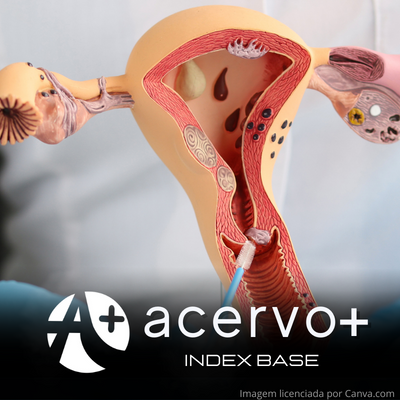Acurácia diagnóstica em linfonodo sentinela no câncer de endométrio
##plugins.themes.bootstrap3.article.main##
Resumo
Objetivo: Discorrer sobre a pesquisa de linfonodo sentinela no câncer de endométrio – acurácia diagnóstica e impactos no serviço hospitalar de referência da Amazônia Ocidental. Métodos: O trabalho foi realizado a partir de um estudo prospectivo, analítico, do tipo experimental, buscando identificar os linfonodos sentinela no câncer de endométrio. Resultados: Os resultados encontrados no período de novembro/2020 a fevereiro/2022, identificaram 12 pacientes com diagnóstico de linfonodo sentinela no câncer de endométrio. A maior queixa foi adenocarcinoma de origem endometrioide grau 1, já para técnicas de injeção foram avaliadas azul patente, no colo uterino em 3, 6 e outro em 0, 3, 6 e 9h, e sobre o mapeamento realizado no decorrer do trabalho. Conclusão: Os procedimentos de pesquisa de linfonodos sentinelas no presente trabalho evidenciou que os achados dos exames pré-operatórios, o tipo de operação, o diagnóstico pós-operatório, a técnica de injeção e o tipo de mapeamento demonstraram diversos achados entre os casos observados e desta forma cada paciente precisou passar por um tipo de conduta específica até o final do tratamento. Desta forma é preciso avaliar cada caso especificamente buscando oferecer o melhor tratamento a paciente.
##plugins.themes.bootstrap3.article.details##
Copyright © | Todos os direitos reservados.
A revista detém os direitos autorais exclusivos de publicação deste artigo nos termos da lei 9610/98.
Reprodução parcial
É livre o uso de partes do texto, figuras e questionário do artigo, sendo obrigatória a citação dos autores e revista.
Reprodução total
É expressamente proibida, devendo ser autorizada pela revista.
Referências
2. BOER SM, et al. Toxicity and quality of life after adjuvant chemoradiotherapy versus radiotherapy alone for women with high-risk endometrial cancer (PORTEC-3): an open-label, multicentre, randomised, phase 3 trial. The Lancet Oncology.August 2016; 17 (8): 1114–1126.
3. CIRISANO FD JR, et al. Epidemiologic and surgicopathologic findings of papillary serous and clear cell endometrial cancers when compared to endometrioid carcinoma. Gynecol Oncol. 1999;74(3):385-94.
4. DANIELS MS. Genetic testing by cancer site: uterus. Cancer J, 2012; 18;4: 338-342.
5. EVERETT E, et al. The effect of body mass index on clinical/pathologic features, surgical morbidity, and outcome in patients with endometrial cancer. Gynecol Oncol, 2003; 90;1:150–7.
6. FADY KC, et al. Divisão de Oncologia e Ginecológica, Maimonides Medical Center, Brooklyn. Nova York, 2016.
7. FEDERAÇÃO BRASILEIRA DAS ASSOCIAÇÕES DE GINECOLOGIA E OBSTETRÍCIA E SOCIEDADE BRASILEIRA DE CANCEROLOGIA. Carcinoma endometrial: tratamento, Diretrizes em Foco, 2011.
8. FERLAY J, et al. Estimating the global cancer incidence and mortality in 2018: GLOBOCAN sources and methods. Int J Cancer, 2019; 144:1941-1953.
9. FEDERAÇÃO INTERNACIONAL DE GINECOLOGIA E OBSTETRÍCIA (FIGO). FIGO Committee on Gynecologic Oncology. FIGO staging for carcinoma of the vulva, cervix, and corpus uteri. Int J Gynaecol Obstet. 2014; 125;2: 97-8.
10. FOLEY K, LEE RB. Surgical complications of obese patients with endometrial carcinoma. Gynecol Oncol,1990; 392: 171–4.
11. HAN G, et al. Endometrial Carcinomas With Clear Cells: A Study of a Heterogeneous Group of Tumors Including Interobserver Variability, Mutation Analysis, and Immunohistochemistry With HNF1beta. Int J Gynecol Pathol, 201;5 34;4:323-333.
12. INSTITUTO NACIONAL DE CÂNCER (INCA). Estimativa 2020: Incidência de Câncer no Brasil. Rio de Janeiro, 2019; 120.
13. INSTITUTO NACIONAL DO CÂNCER (INCA). 2014. Disponível em: http:// www.inca.gov.br/estimativa/2014/sintese-de-resultados-comentarios. Acessado em: 25 set. 2022.
14. JEMAL A, et al. Global cancer statistics. CA Cancer J Clin., 2011; 61: 69-90.
15. KHOURY-COLLADO F, et al. Sentinel lymph node mapping for endometrial cancer improves the detection of metastatic disease to regional lymph nodes.Gynecol Oncol., 2011; 122: 251-4.
16. MELO AFB, et al. Estudo Prospectivo Randomizado comparando o Azul Patente e o Azul de Metileno na indentificação do Linfonodo Sentinela em pacientes com Câncer de Mama. In: Congresso de Pesquisa, Ensino e Extensão da UFG (CONPEEX), Goiânia. Anais eletrônicos do XIV Seminário de Iniciação Cientifica [CD-ROM]. Goiânia: UFG, 2006; 3.
17. MORICE P, et al. Endometrial cancer. Lancet, 2016; 387(10023):1094–1108.
18. MUTCH DG. The new FIGO staging system for cancers of the vulva, cervix, endometrium and sarcomas. Gynecologic Oncology, 2009; 115(3): 325–328.
19. NADEEM RA, The Increasing Credibility of Sentinel Lymph Node Mapping in Endometrial Cancer. Gynecology Service, Department of Surgery, Memorial Sloan-Kettering Cancer Center, 2012; 100: 65.
20. ORGANIZAÇÃO DAS NAÇÕES UNIDAS. Agency for Research on Cancer. Cancers of the female reproductive tract. WORLD cancer report iarc Press Lyon, 2003; 215.
21. ORELLANA HR, et al. Cáncer de endometrio: experiencia de 10 años em el hospital San Juan de Dios. Rev. chil. obstet. Ginecol, 2013; 78.
22. PERES A, BARRANGER E. Arguments contre le ganglion sentinelle dans le cancer de l’endomètre: les arguments en sa défaveur Gynécologie Obstétrique & Fertilité, 2012; 40:264– 26.
23. ROCHA LLS, et al. Linfonodo sentinela no câncer de endométrio: Revisão narrativa. Revista Eletrônica Acervo Saúde / Electronic Journal Collection Health (REAS/EJCH), 2019; 11(5): 302.
24. SCUCCES M. Epidemiología del carcinoma de endometrio. Rev Obstet Ginecol Venez., 2010; 70(1): 37-41.
25. SIEGEL RL, MILLER KD. Estatísticas de câncer, 2017. CA Cancer J Clin., 2017; 67: 7-30.
26. ZHANG Y, WANG J. Controversies in the Management of Endometrial Carcinoma. Corporation Obstetrics and Gynecology International, 2010; 16.

